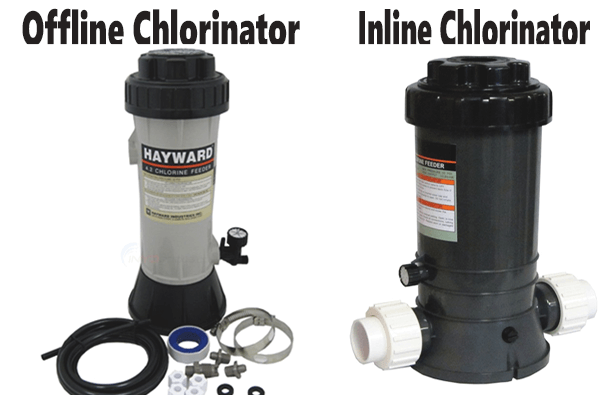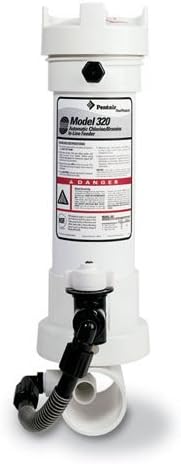When you are in the market for purchasing a pool chlorinator, you heard these two common words:
- Inline chlorinator
- Offline chlorinator
Both of them function in the same way, and the price of them is also the same.
The only difference between inline and offline chlorinators is the installation process or where you installed them. In this comparison guide on inline vs. offline chlorinator, we let you know the difference between them.

The best part is- you can also learn how to install inline chlorinator with your pool system.
Contents
Comparison of Inline and Offline Chlorinator
| IMAGE | PRODUCT | DETAILS | ||
|---|---|---|---|---|
Best Inline Chlorinator
| Best Inline Chlorinator | Hayward CL200 In-line Automatic Chemical Feeder |
| Check on Amazon |
Best Inline Chlorinator for Large Pool
| Best Inline Chlorinator for Large Pool | Pentair R171096 Rainbow 320 Automatic In-Line Chlorine/Bromine Feeder |
| Check On Amazon |
Best Off-line Chlorinator
| Best Off-line Chlorinator | Hayward CL220 Off-line Automatic Chemical Feeder |
| Check Best Price |
Best Off-line Chlorinator for Spa
| Best Off-line Chlorinator for Spa | Pentair R171056 Rainbow Automatic Chlorine/Bromine Off-Line Feeder |
| Check On Amazon |
Difference Between Inline and Offline Chlorinators
In this chapter, you can learn the difference between inline chlorinator and offline chlorinator. So, let’s dive into it.
Installation Process
The first and foremost difference between both types of chlorinators is where they plumbed into.
Inline chlorinator, what’s the name suggest, is installed in-line with your pool. In simple words, you need to cut the main pipe (connected with the filter & the pool system) and install the inline chlorinator into it.
On the other hand, you need to install the offline chlorinator on the side of your pool pump & filter. Then, it requires to connect with the system through a tube.
Water Flow
Water flow is another significant difference between inline and offline chlorinators.
The water flow rate of the inline chlorinator is lower compared to its counterpart. Due to the low flow rate, this chlorinator fails to dissolve the chlorine tablets. So, you can’t sanitize your pool water thoroughly.
On the other hand, an offline chlorinator provides better water flow compared to inline chlorinators. Due to its design, the water flow first reaches the chlorinator before the filter.
As a result, it can dispense the chlorine tablets evenly and sanitize the pool water thoroughly.
Ease of Installation
In case of easy installation, an inline chlorinator will be your best bait. You just need to cut into the main pipe connected with the filter and install it there. So, it doesn’t require extra attachments like hoses, pipes, and clamps.
On the other hand, an offline chlorinator needs extra pipes, hoses, and others to install. So, it’s a bit challenging to attach the chlorinator to your pool system.
Ease of maintenance
Inline chlorinator is easy to maintain as it doesn’t have a lot of attachments. You can effortlessly detach it from your pool system and clean the chlorinator.
In contrast, an offline chlorinator has many attachments. Detaching them from the system is difficult and also time-consuming.
Therefore, the repairing cost of an offline chlorinator is high compared to the inline chlorinator.
How to Install Inline Chlorinator?
Let’s see the step by step guide to install the inline chlorinator.
Step 1
Make sure you have the equipment at your fingertips, including PVC glue, felt-tipped pen, and hacksaw.
Then, turn the electricity off go through the pump motor.
Step 2
Set the chlorinator after the filter and heater.
Step 3
According to the fitting size, pick the pipe that can be attached to the fitting. Then, put together the pipe on both sides of the fitting. Ensure that the washer is in the right place, and the fitting is tight enough.
Step 4
On the outflow pipe, place the assembly and marks on each side of the fitting. Measure 3-4 inches from the mark you just made. Then, make another mark with your felt pen. And it will be the mark where you cut the pipe.
Step 5
In this step, cut the pipe inside the marking.
Now, insert the inline chlorinator to the pipe to check whether it is fit or not. Then, apply glue inside of the chlorinator fitting and on the pipe.
And finally, insert your inline chlorinator into the pipe and hold it straight until the glue is set. Are you interested to learn how to install the offline chlorinator? Then, check out this guide.
Conclusion
So, which is the best chlorinator: inline vs. offline chlorinator?
From the above, you learned about the difference between inline chlorinator and offline chlorinator. Both of them are used to sanitize your pool water by producing chlorine.
However, you can go for an inline chlorinator for easy installation, maintenance, and pleasing appearance.
In contrast, an offline chlorinator will be your best bait for its superior sanitization capacity. The greater water flows efficiently dissolves the chlorine tablet and keeps your pool water fresh.




